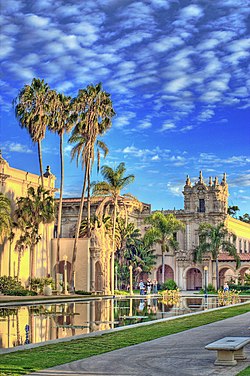
| History of California |
|---|
 |
| Periods |
| Topics |
| Cities |
| Regions |
| Bibliographies |
|
|
The written (as opposed to oral) history of the San Diego, California, region began in the present state of California, when Europeans first began inhabiting the San Diego Bay region. As the first area of California in which Europeans settled, San Diego has been described as "the birthplace of California".[1]
Explorer Juan Rodriguez Cabrillo was the first European to discover San Diego Bay in 1542, roughly 200 years before other Europeans settled the area. Native Americans such as the Kumeyaay people had been living in the area for as long as 12,000 years prior to any European presence.[2]
A fort and mission were established in 1769, which gradually expanded into a settlement under first Spanish and then Mexican rule. San Diego officially became part of the U.S. in 1848, and the town was named the county seat of San Diego County when California was granted statehood in 1850. It remained a very small town for several decades, but grew rapidly after 1880 due to development and the establishment of multiple military facilities. Growth was especially rapid during and immediately after World War II. Entrepreneurs and boosters laid the basis for an economy based today on the military, defense industries, biotech, tourism, international trade, and manufacturing. San Diego is now the eighth largest city in the country and forms the heart of the larger San Diego metropolitan area.
- ^ McGrew, Clarence Alan (1922). City of San Diego and San Diego County: the birthplace of California. American Historical Society. Retrieved 26 October 2012.
- ^ Erlandson, Jon M.; Rick, Torben C.; Jones, Terry L.; Porcasi, Judith F. (2010). One If by Land, Two If by Sea: Who Were the First Californians?. AltaMira Press. ISBN 978-0-7591-1960-4.
© MMXXIII Rich X Search. We shall prevail. All rights reserved. Rich X Search
